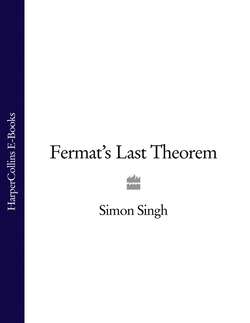Читать книгу Fermat’s Last Theorem - Simon Singh, Simon Singh - Страница 17
Birth of a Riddle
ОглавлениеFermat’s judicial responsibilities occupied a great deal of his time, but what little leisure he had was devoted entirely to mathematics. This was partly because judges in seventeenth-century France were discouraged from socialising on the grounds that friends and acquaintances might one day be called before the court. Fraternising with the locals would only lead to favouritism. Isolated from the rest of Toulouse’s high society, Fermat could concentrate on his hobby.
There is no record of Fermat ever being inspired by a mathematical tutor; instead it was a copy of the Arithmetica which became his mentor. The Arithmetica sought to describe the theory of numbers, as it was in Diophantus’ time, via a series of problems and solutions. In effect Diophantus was presenting Fermat with one thousand years worth of mathematical understanding. In one book Fermat could find the entire knowledge of numbers as constructed by the likes of Pythagoras and Euclid. The theory of numbers had stood still ever since the barbaric burning of Alexandria, but now Fermat was ready to resume study of the most fundamental of mathematical disciplines.
The Arithmetica which inspired Fermat was a Latin translation made by Claude Gaspar Bachet de Méziriac, reputedly the most learned man in all of France. As well as being a brilliant linguist, poet and classics scholar, Bachet had a passion for mathematical puzzles. His first publication was a compilation of puzzles entitled Problemes plaisans et délectables qui se font par les nombres, which included river-crossing problems, a liquid-pouring problem and several think-of-a-number tricks. One of the questions posed was a problem about weights:
What is the least number of weights that can be used on a set of scales to weigh any whole number of kilograms from 1 to 40?
Bachet had a cunning solution which shows that it is possible to achieve this task with only four weights. His solution is given in Appendix 4.
Although he was merely a mathematical dilettante, Bachet’s interest in puzzles was enough for him to realise that Diophantus’ list of problems were on a higher plane and worthy of deeper study. He set himself the task of translating Diophantus’ opus and publishing it so that the techniques of the Greeks could be rekindled. It is important to realise that vast quantities of ancient mathematical knowledge had been completely forgotten. Higher mathematics was not taught in even the greatest European universities and it is only thanks to the efforts of scholars such as Bachet that so much was revived so rapidly. In 1621 when Bachet published the Latin version of the Arithmetica, he was contributing to the second golden age of mathematics.
The Arithmetica contains over one hundred problems and for each one Diophantus gives a detailed solution. This level of conscientiousness was not a habit which Fermat ever picked up. Fermat was not interested in writing a textbook for future generations: he merely wanted to satisfy himself that he had solved a problem. While studying Diophantus’ problems and solutions, he would be inspired to think of and tackle other related and more subtle questions. Fermat would scribble down whatever was necessary to convince himself that he could see the solution and then he would not bother to write down the remainder of the proof. More often than not he would consign his inspirational jottings to the bin, and then move on to the next problem. Fortunately for us, Bachet’s publication of the Arithmetica
